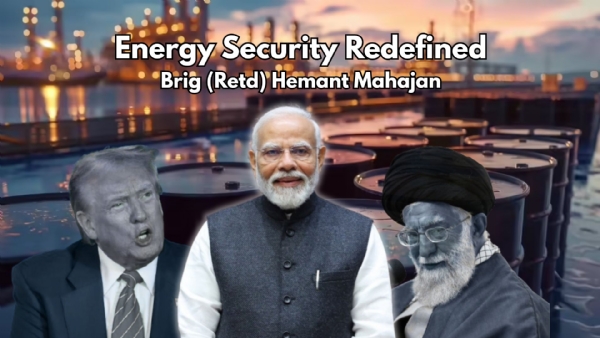Energy Security Redefined:India’s Proactive Approach to Global Supply Challenges
India has one of the largest refining capacities in the world, which allows it to process crude oil from various sources efficiently, enhancing energy security
Total Views |
"In the midst of chaos, there is also opportunity."
Introduction
The Gulf of Hormuz is one of the most critical chokepoints in global energy supply chains, handling nearly 20% of the world's oil and a significant share of LNG exports. Any disruption, such as closure due to geopolitical tensions or conflict, can lead to severe price volatility and supply insecurity. For energy-import-dependent countries, such a crisis is a major strategic concern.

In this context, India has positioned itself strategically to handle potential energy crises better than its regional counterparts, such as China and Pakistan. India, despite being one of the largest energy consumers and importers, is relatively better positioned to handle such a disruption due to its diverse sourcing, strategic reserves, and diplomatic strategies.
India’s Unique Advantage: Diversified Oil Import Basket
India has actively engaged in forming bilateral and multilateral energy agreements to enhance energy security.
India has proactively diversified its crude oil import sources to reduce overdependence on the Middle East:
Russia: Since the Ukraine conflict, India has significantly increased imports of discounted Russian Urals crude, now constituting over 35% of total imports. This oil bypasses the Gulf of Hormuz.
United States: India has boosted imports of both crude and LNG from the U.S., routed via the Atlantic.
Africa: Countries like Nigeria and Angola supply a considerable volume of India’s crude needs.
Latin America: Brazil and Guyana have emerged as recent partners in India’s energy diversification.
Middle East: Imports continue from UAE, Iraq, and Saudi Arabia, but alternative routes (e.g., Red Sea, Suez Canal) reduce dependence on Hormuz.
Initiatives like the International Solar Alliance and participation in forums such as the Shanghai Cooperation Organization (SCO) foster collaborative approaches to energy security.
Strategic Petroleum Reserves (SPR): India’s Energy Buffer
India currently has an SPR capacity exceeding 5.3 million tonnes (around 39 million barrels), covering 9-10 days of national demand. When combined with stocks held by public oil marketing companies, India has a buffer of around 30-35 days. India has built reserves in locations such as Visakhapatnam, Mangalore, and Padur.
These reserves can sustain the country's oil needs for a significant duration, providing a cushion against disruptions.
Plans are underway to expand SPR capacity further, strengthening India’s emergency response capabilities during supply shocks.
Energy Policy and Forward Contracts
India has long-term agreements with countries like Russia and UAE, ensuring stability in pricing and supply.
Currency flexibility, especially with Russia (INR-RUB deals), helps India shield itself from dollar price fluctuations.
Government policies also focus on maintaining excise flexibility and subsidy frameworks to control domestic inflation.
Growth of Domestic Refining and Alternate Fuels
India is among the top five countries globally in terms of refining capacity.
It imports crude oil and refines it domestically, which adds flexibility and value addition.
Renewable Energy: Significant progress has been made in ethanol blending, bio-diesel, green hydrogen, and solar/wind energy.India has made substantial investments in renewable energy, particularly solar and wind. The government has set ambitious targets to increase the share of renewables in its energy mix, which will help reduce reliance on fossil fuels over time.
Initiatives like the National Green Hydrogen Mission aim to make India a global leader in clean energy.
Strategic Infrastructure Development
India has focused on developing its energy infrastructure, including:
Refineries: India has one of the largest refining capacities in the world, which allows it to process crude oil from various sources efficiently, enhancing energy security.
Logistics: Investment in pipelines, ports, and transportation networks facilitates smoother energy importation and distribution, reducing vulnerability to supply chain disruptions.
Domestic Production Enhancements
India is making strides in boosting domestic oil and gas production.
Exploration and Production: The government has incentivized exploration and production through policies aimed at attracting foreign investment in the oil and gas sector.
Gas Production: Increasing domestic gas production through initiatives in shale gas and offshore drilling helps reduce reliance on imports.
Energy Efficiency Measures
India is adopting energy efficiency measures to lower overall consumption.
Policies and Initiatives: Programs like the Perform, Achieve and Trade (PAT) scheme promote energy efficiency in industries, helping to reduce overall energy demand.
Public Awareness: Campaigns aimed at promoting energy conservation among consumers contribute to more sustainable energy consumption patterns.
Converting crisis into opportunity
Price Transmission: Global price surges help India to sell refined products like petrol & diesel at competitive prices.
Insurance & Freight: Maritime transport will be costlier due to higher war-risk premiums especially in Red sea.
LNG Vulnerability: LNG from Qatar may be affected; alternative suppliers from Australia and the U.S. are being considered.
Diplomatic and Geo-Strategic Leverage
India’s multi-alignment foreign policy allows it to balance relations with the U.S., Russia, Gulf countries, and Africa.
Strong diplomatic ties provide India with multiple fallback options during energy crises.
Active participation in forums like IEA, SCO, BRICS also enhances India’s energy diplomacy reach.
Additional Factors Favouring India
Private Sector Participation: Companies like Reliance and Nayara have global supply chains and flexible logistics.
Digital Infrastructure: Real-time monitoring of global oil markets and predictive modelling aid in better decision-making.
Policy Agility: India has demonstrated quick fiscal and trade responses during past global oil price spikes.
Conclusion
The closure of the Gulf of Hormuz would create global energy turmoil, but India is strategically better prepared than many of its peers. Through diversification, diplomatic engagement, robust refining infrastructure, and alternative energy development, India has built a resilient energy security framework. While price shocks may still affect the economy, the country is unlikely to face a severe supply disruption, reinforcing its status as a pragmatically prepared global energy consumer. These measures not only enhance India’s energy security but also provide a buffer against potential crises, distinguishing it from nations like China and Pakistan, which may be more vulnerable due to their concentrated energy sourcing and less developed strategic frameworks.
--


